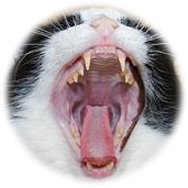

 | knowyourcat.info |

In nature, wild cats provide their own dental care by chewing on different textures when they catch and eat their prey. But domestic cats are mainly fed processed diets.
Although very palatable, nutritious and healthy in other ways, processed foods are less beneficial when it comes to dental health. As a result, dental problems with cats are becoming more common.
It is therefore important to check your cat's teeth and mouth on a regular basis. The problem is, of course, that this is generally more easily said than done. Prising the cat's month open is not painful for the cat, (unless there is a damaged tooth, or gum infection), but most cats bitterly resent your taking such liberties.
Cats have very sharp teeth, and bites can be nasty. Bites are not only painful but also carry bacteria which can cause infection and severe inflammation. If you have been bitten by a cat, never ignore it. Go to the GP and get a dose of antibiotics to stop any potential infection.
Because of the risks involved, if a mouth examination is likely to bring you a lot closer to your cat's teeth than you had intended, you would do better leaving it to the vet. When the cat is very uncooperative, especially if there is a painful tooth, a proper examination may need anaesthetic first.
If you want to take your life into your hands and try a home examination, first put one hand at the back of the cat's head, stroking gently, and with your fingers lift the upper lip to reveal the front teeth.
You may want to start with just one side first. This will allow you to examine the outside of the teeth and the gums. If the cat is cooperating you can try prising the mouth open by gently pushing the lower jaw down. Even if the cat will not allow you to inspect her mouth properly, try looking inside when she yawns. This quick inspection will give you an idea about the colouring of the teeth and gums.
Ideally you'll see healthy white teeth and pink gums. No odor on cat's breath and a mobile intact tongue. Signs of trouble include -
more on the next page
If the cat has toothache and gum disease there may be easy clues, for example, if cat is hungry and tries eating but after a short while jumps back and walks away.
Like with most things, never use human products for a cat (or vice versa!). However, there are toothpastes which have been specially designed with cat-friendly flavours, including meat, fish and malt. The important thing is that they are designed to be swallowed (in small amounts) and many do not need rinsing out afterward.
There are also specially designed toothbrushes which you can get from pet stores. Although desirable, brushing your cat's teeth is not easy unless your cat has been trained from kittenhood. If your cat is not willing to participate in the daily chore of tooth brushing you can simply put a little toothpaste directly into her mouth or on a paw for her to lick. Her tongue will then do the rest.
There are also foods designed specifically with oral hygiene in mind. Look for products with 'dental' in the name, for example dentabits, dental treats, denta paws etc. These treats are designed to protect your cat's teeth from plaque and tartar accumulation.
The information supplied here is intended as a guideline only.
 |

